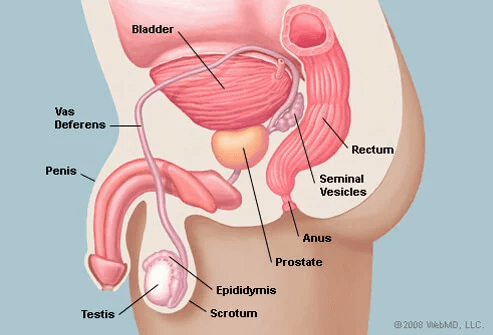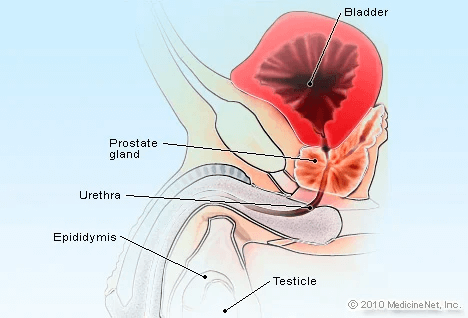We see men for a any problem relating to bladder control problems that may or may not be linked to the prostate. We also see men with pain problems relating to the prostate and also epididymis, which as you will be reminded, is not actually part of the prostate. We find ourselves often explaining the basic anatomy of the body to try and help men understand why things have gone wrong and why certain strategies for regaining control make sense.
The Prostate, is a gland which sits inside the body, beneath the bladder and above the penis. It is traditionally described as “walnut shaped”. It actually wraps around the urethra (bladder tube that allows urine to pass from the bladder, down through the penis and out).
The Prostate is a gland which produces prostatic fluid, an essential component of semen. Semen is the carrier fluid that enables sperm to pass into the female body and stay viable until fertilisation can take place.
Lets go back a little further
If we go back to the beginning however, we should start with the testes. This is where the sperm is produced. There is a coiled, tubular structure called the epididymis at each testis. The epididymus collects sperm before it passes along the vas deferens. The vas deferens is a firm tube which passes, along with spermatic cord, up to the top of the prostate into the seminal vesicle. The seminal vesicle produces semen which is mixed with the sperm. This seminal fluid now passes through the prostate along a tube called the ejaculatory duct and joins the urethra. From here, the seminal fluid is ejected with force (ejaculation) when sexual arousal occurs.
The prostate adds extra fluid to the semen. The fluid is called prostatic fluid and helps to make the semen optimal for carrying sperm. The prostate therefore has glandular tissue which produces the prostatic fluid but also muscular areas so that when ejaculation occurs, the prostate helps to close the urethra up to the bladder so preventing urine passing with ejaculation.
Broad diagram of the prostate and bladder
The following diagram will help to make the prostate function clear. This picture is kindly reproduced with permission of medicine net.

This shows an overview of pathway from testis to seminal vesicle, and from vesicle into prostate with urethra exiting the prostate to the penis.
More detail of the prostate
The next picture shows that from the seminal vesicle there is a duct which passes to the urethra. The seminal vesicle is not marked but it is the area to the right of the base of bladder above the prostate.The ejaculatory duct passes down to the urethra in the prostate.

Prostatitis
So the prostate tissue can become infected and cause pain and discomfort. You will be treated with antibiotics to clear the infection. Sometimes, when pain has been present, the pelvic floor muscles which are just below the prostate, go into spasm and become painful too. If the infections keep coming back, or simply the muscles become persistently tight and painful, the muscles themselves may become the driver of the pain and no infection is now present.
Epididymitis
Likewise, we sometimes see men who have been diagnosed with an infection in the epididymis, “epididymitis”. Pain may have been specific to the testicle. Again, the pelvic floor can become involved in the same way, ie spasm sets in and the muscle need to be treated to help clear the pain.
BPH (benign prostatic hypertrophy)
The prostate tissue itself has a tendency to enlarge with age which is called Benign (so NOT cancer) Prostatic Enlargement. If the prostate enlarges, the bladder can’t empty properly. This leads to urinary frequency and urgency and often getting up at night too many times. Treatment is called a “TURP” ie your Urologist will remove the excess tissue so allowing the urine to pass easily again. Unfortunately, if the bladder muscle has been working hard to empty a constricted tube for a long time, men may find that they are more urgent and may even leak just after the operation. We can help to get you back on track and use your pelvic floor muscles and do some bladder training to regain control.
Prostate Cancer
Prostate Cancer can occur in the tissue of the prostate and may or may not cause symptoms. This is why it is so important to pay attention if the bladder is showing signs of not emptying well or you start to get up at night too often. After 50 years of age, your Doctor will usually do blood tests to check your “PSA”. This is “prostate specific antigen” and if it goes up significantly, can be a sign that something is wrong. Doctors also examine the prostate via the rectum….the “DRE” ie digital rectal exam. Hopefully it will be nothing sinister. If cancer is found early it can be managed by careful monitoring to check it isn’t changing over time, or the prostate can be removed, or radiation can be used to kill off the cancer cells.


